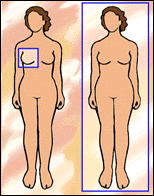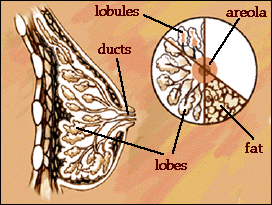
|

|

Invasive cancer is cancer that has spread from inside your breast duct or lobule to invade other parts of your breast. When breast cancer spreads to other parts of your body, this is called "metastasis." The cancer cells circulate in your blood until they invade a body part and grow there. They often settle in the liver, lungs, or bones. Treatment for invasive cancer usually requires both local and systemic treatments.
Caption: Local treatment (on the left) is done to eliminate the cancer that is in your breast itself, and often consists of the removal of the cancer tissue combined with local radiation therapy.
Caption: Systemic treatment (on the right) is done to treat possible or actual tumor cells (no matter where they are) that may have spread. Systemic treatment fights cancer all over your body, not just in your breast.
Chemotherapy:
Chemotherapy is the use of drugs which destroy cancer cells. Chemotherapy stops cancer cells from multiplying at different points in the cancer cells' life cycle.
Hormone Therapy:
Hormones are substances that are naturally produced in your body, however they may help some cancers grow faster. Hormone therapy stops the cancer cells from responding to your bodies hormones, stopping or slowing your cancer's growth.
Benign tumors are not cancer. They will not spread to other parts of your body, and they are seldom a threat to your life. Often, benign tumors can be removed with surgery, and they are not likely to return.
Malignant tumors are cancerous. They can spread and kill nearby tissues and organs. Cancer cells also can break away from the main tumor and enter the bloodstream and the lymphatic system. This process of cancer spreading to other parts of your body is called metastasis. Even if a malignant cancer tumor is removed from your breast, the disease may return if the cancer cells had spread to other parts of your body before the tumor was removed.
A healthy cell is born, lives a short life, and then dies. Cancer cells are different. Cancer cells cultivated in a laboratory do not die as quickly Ð they continue to grow and start new tumors. Cancer cells don't live normal cell cycles. Their uncontrolled birth and delayed death make cancer cell growth rapid, widespread and destructive.
Early detection and early treatment are the only ways we know to stop cancer. Even if you have advanced cancer, it is recommended that you seek treatment to reduce it's destructive effects.
Factors that increase a woman's chances of getting the disease are usually things you have no control over, like age and family history. Most common types of nodules and fibrocystic changes of the breast do not increase your risk of breast cancer.
Age: About 75 percent of all breast cancers are found in women over the age of 50. The disease is uncommon in women under the age of 30.
Family History: The risk of getting breast cancer increases for a woman whose mother, sister, or daughter had the disease - particularly if she had the disease before she reached menopause.
Personal History: About 15 percent of women treated for cancer in one breast are likely to get cancer in the other breast later on.
Each lobe has many smaller lobules which end in dozens of tiny bulbs which produce milk. The lobes, lobules, and bulbs are all linked by thin tubes called ducts.
These ducts carry milk from the lobes to your nipple, located in the center of the dark area of skin on your breast called the areola.
The spaces between the milk-producing parts of your breast are filled by fat. Muscles cover your ribs and lie under your breast, but they are not part of your breasts. up to Contents of this Page
up to Contents of this Page
Systemic treatment kills or slows the growth of cancer cells that have spread in your body. Which systemic treatments will be most effective are determined by many different methods, including an axillary node dissection (which is discussed fully in the Diagnosis section). If you are "node positive," you may need more aggressive treatment than if you are "node negative." There are two main types of systemic treatments: chemotherapy and hormone therapy. up to Contents of this Page
up to Contents of this Page
Cancer is the name for a group of diseases in which abnormal cells grow and displace normal body tissue. Normally, healthy cells in your body grow, divide, die and replace themselves in an orderly way. This process keeps your body in good repair. Sometimes, cells lose the ability to control their growth. They grow too rapidly without any order, making too much tissue and forming tumors. These tumors can be benign (not cancer) or malignant (cancer). up to Contents of this Page
up to Contents of this Page
Cancer is almost always a treatable disease if it is detected early enough. It is much easier to treat before it has spread. But cancer is often lethal if left unchecked. Malignant cancer at the most basic level is abnormal cell growth that reaches out creating new abnormal cells, while it's center core consumes healthy cells in the breast. This creates a tumor, which is a lumped group of abnormal cells. Cancer cells often spread through the body. Medical scientists call this autonomy, meaning the cancer works on it's own. Some health care professionals have even compared cancer to an unruly street gang, a disorganized mob that has no rules for how living cells normally behave.  up to Contents of this Page
up to Contents of this Page
Breast cancer is not caused by bumping, bruising, or touching the breast Ñ nor is breast cancer contagious Ñ no one can catch breast cancer from another person.  up to Contents of this Page
up to Contents of this Page
 The main biological function of the female breast is to produce milk. Each of your breasts has 15 to 20 sections, called lobes, that are arranged in a flower shape like petals on a daisy. Lobes fill up with milk when a women is breastfeeding.
The main biological function of the female breast is to produce milk. Each of your breasts has 15 to 20 sections, called lobes, that are arranged in a flower shape like petals on a daisy. Lobes fill up with milk when a women is breastfeeding.
